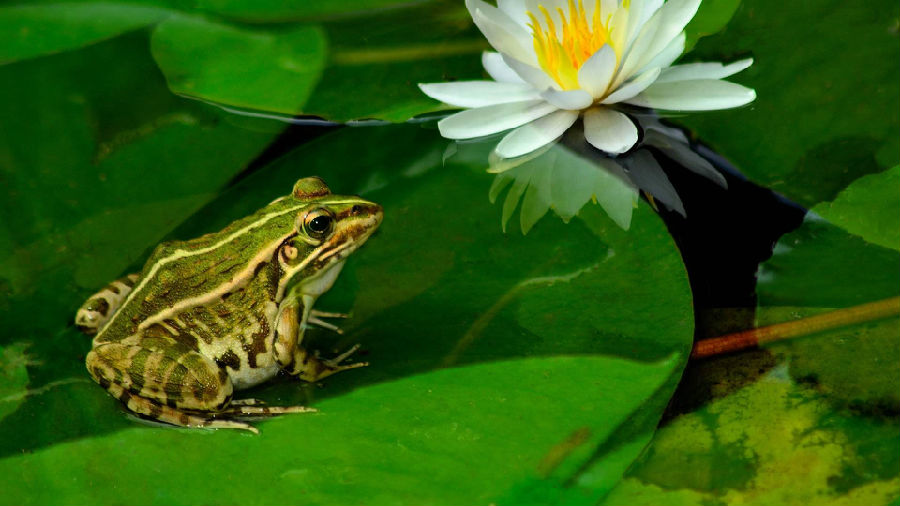(单词翻译:单击)
听力文本
This is Scientific American — 60-Second Science. I'm Christopher Intagliata.
You might think frogs catch insects 'cause their tongues are sticky. "But why is the tongue sticky, and how does it actually adhere to these insects at these very high accelerations?"
Those are the questions Alexis Noel, a PhD candidate in mechanical engineering at Georgia Tech, wanted to answer. So she and her team got frog tongues from a dissection lab, and tested their consistency. Ten times softer than human tongues. A texture more like brain tissue. "Their tongue is very much like a sponge. It's infused with this thick, viscous saliva."
That saliva was their next study subject. "And in order to test the saliva we had to get about a fifth of a teaspoon of fluid. Which is a lot of saliva, in a frog's case." They put the saliva in a rheometer, a tool that can measure viscosity. And they found that frog saliva is what's called a 'shear-thinning fluid'—its viscosity changes, depending on conditions.

You might be more familiar with a different shear-thinning fluid. "Ketchup. When you smack the bottom of the ketchup bottle you're actually invoking shear forces within the ketchup itself. And ketchup, because it's shear thinning, its viscosity actually drops and allows it to slide out of the bottle easily."
So back to our frogs: the tongue shoots out, hits the bug and deforms around it. That impact is like a smack on a ketchup bottle—it changes the saliva from thick and sticky to more watery, free to flow all over the bug. Then the tongue bounces back, like a bungee cord, and the saliva thickens up again. What's next is beyond weird.
"Frogs actually take their bulbous eyeballs and bring them down into their mouth cavity and use their eyeballs to shove the insect down the throat." That force turns the saliva watery again, "and the insect slides down the gullet." The study is in the Journal of the Royal Society Interface.
With the case closed on this one, Noel's next inquiries are on grippy fingertips. The dust-collecting properties of earwax. And—wait for it—cat tongues. "Yeah, I get paid to watch cat videos all day."
Thanks for listening for Scientific American — 60-Second Science Science. I'm Christopher Intagliata.
参考译文
这里是科学美国人——60秒科学。我是克里斯托弗·因塔利亚塔。
你可能认为青蛙能捕食昆虫是因为它们的舌头是粘的。“但是为什么它们的舌头是粘的,青蛙又是如何在昆虫快速移动的时候黏住它们的呢?”
这些问题都是在乔治亚理工大学攻读机械工程博士的亚历克西斯·诺埃尔想回答的问题。所以,她和研究团队从解剖实验室获取了一些青蛙的舌头,并且检测了这些舌头的的粘度。青蛙舌头的柔软性是人类舌头的十倍。而其纹理更像大脑组织。“青蛙的舌头就像一块海绵。充满了粘稠的唾液。”
青蛙的唾液是他们下一个研究课题。“为了测试青蛙唾液,我们得收集五分之一茶匙的唾液。对一只青蛙而言,这是很多的唾液。”然后他们将唾液放入一个流变仪中,流变仪是可以测量粘稠度的工具。研究人员发现,青蛙的唾液是一种“剪切稀化液体”,也就是说其粘稠度依据情况而改变。
也许你对另一种剪切稀化液体更为熟悉。“那就是番茄酱。当你拍打番茄酱瓶底部时,实际上是在激活番茄酱内含的剪切力。番茄酱的剪切稀化会使其粘度下降,然后番茄酱就会轻松地顺着瓶子滑下来。”
现在说回青蛙:青蛙的舌头弹出来,击中虫子,并且缠绕住虫子使其变形。这种冲击就像拍番茄酱瓶底一样,它使又厚又粘的唾液稀释,轻松自由地流过虫子的全身。然后青蛙的舌头像弹簧绳一样弹回,唾液再次变得粘稠。接下来的事情就更奇怪了。
“青蛙将球状眼珠压入口腔,随后用眼珠把昆虫推入喉咙。”这种力量使唾液再次稀释,“然后昆虫就会顺着咽喉滑下去。”该研究发表在《皇家学会界面》期刊上。
这个课题的研究结束了,诺埃尔下一个研究对象是粗糙指尖。耳垢的集尘特性。等等,还有猫舌头。“没错,我整天都在看猫咪的视频,而且我还能赚到钱。”
谢谢大家收听科学美国人——60秒科学。我是克里斯托弗·因塔利亚塔。
译文为可可英语翻译,未经授权请勿转载!
重点讲解
重点讲解:
1. adhere to 黏附;附着;
例句:Small particles adhere to the seed.
小颗粒牢牢附着在种子上。
2. in order to 为了;以便;目的在于;
例句:They did this in order to head off the crisis.
他们这样做以防止发生危机。
3. depend on 取决于;根据;由…决定;
例句:The outcome will depend on how well we perform.
结果将依我们表现的好坏而定。
4. be familiar with 熟悉的;熟知的;
例句:He was familiar with the process.
这种情况他熟悉。


